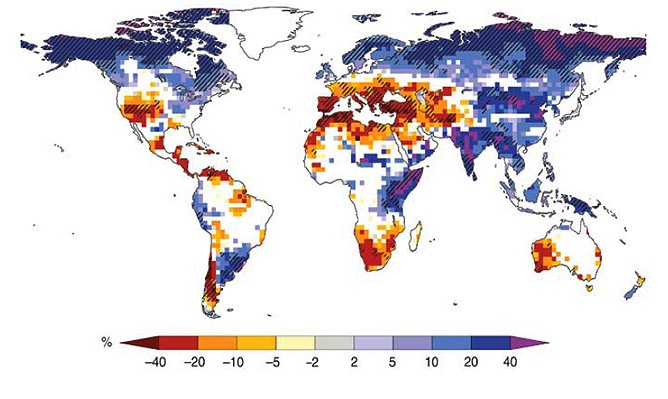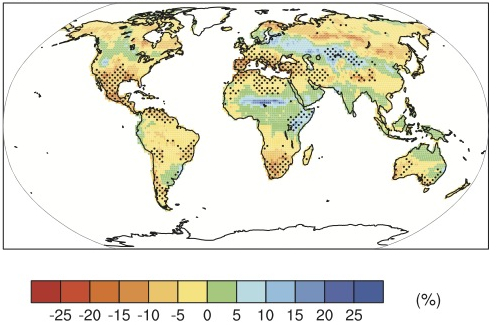Future Geographies:
Water Resources
and Climate Change
Changes to the patterns of current precipitation and those projected for the future on account of climate change are discussed in Chapter 6, "Future Geographies: Global Precipitation Patterns". The kind of precipitation is already changing, as northern regions are experiencing more rain than snow. Total snow cover has on average decreased in both hemispheres.The variability of precipitation is changing as well. Many subtropical regions have been or are gripped in devastating droughts. Precipitation is but one element of the hydrologic cycle, that will be affected by climate. The impact of climate change on water resources will have profound effects on ecosystems and humans.
Evapotranspiration
As noted earlier in this chapter, potential evapotranspiration is a measure of water need based primarily on the energy input. Potential evapotranspiration is expected to increase in nearly all regions. As temperature rises the saturation point of air increases, but relative humidity is not expected to change significantly. As a result, the evaporation of water increases yielding a larger amount of water vapor in the air. The increase evaporation of water from the soil places a greater strain on plants as their need for water to maintain growth processes increases. Actual evaporation is projected to increase over most bodies of water, the amount depending on the geographic variation in surface warming.
Plants take in carbon dioxide and release water vapor through their stomata. The increase in atmospheric carbon dioxide has competing roles in the affect of evapotranspiration from vegetation. At higher CO2 concentrations, stomata need to open less to take in the same amount of carbon dioxide for photosynthesis. However, increased carbon dioxide can act a gaseous fertilizer to spur plant growth and leaf area. Increased leaf area results in more transpiration. The degree to which higher CO2 concentration have depend on the type of vegetation, nutrient availability, temperature changes, and water availability
Surface water and Runoff
The impact of climate change on river flows and lake levels resulting depend on changes in the amount, type, and timing of precipitation. Changes in evaporation rates also affect river and lake levels. Global scale climate and hydrological models project runoff increases in the wet tropics and high latitudes, and decreases in the mid-latitudes and some parts of the dry tropics. Most studies show that rising temperatures lead to changes in the seasonality of river flow due to changes in the type of precipitation. Higher winter flows occurring in the European Alps, Scandinavia, the Himalayas, western, central, and eastern North America will result from more precipitation falling as rain and earlier snow melt. The frequency of heavy precipitation events are expected to increase in an ever warming world for most regions. This will likely increase the threat for flash flooding and urban flooding.

Figure 10.18 Runoff model projections of large-scale relative changes in annual runoff
for the period 2090-2099 relative to 1980-1999. Courtesy IPCC
Ground water
Ground water levels are maintained when aquifers are adequately recharged. How this occurs varies with soil conditions, vegetation and precipitation intensity and timing. Generally speaking, if precipitation intensity is greater than the infiltration capacity of the soil, most water will runoff and not percolate down into the ground water zone. However, more frequent and larger precipitation events projected for some humid region may result in decreased groundwater recharge as the infiltration capacity of the soil is exceeded more often. In semi-arid and arid regions, groundwater level may rise with high-intensity storms as rainfall is ability to infiltrate downward before evaporating.
Soil moisture
The amount of moisture held in the soil depends on when and how much precipitation and evaporation occurs at a place. The resulting changes to the spatial patterns of soil moisture is expected to be quite similar to that of changes in precipitation. Though the amount of change is not well established, projections generally agree on the kind of change that will occur. A reduction in soil moisture in the subtropics and Mediterranean regions will accompany a decrease in precipitation. Projected decreases in snow cover at high latitudes will also result in less soil moisture. Soil moisture will likely increase in East Africa and central Asia where increases precipitation is expected to occur.

Figure 10.19 Fifteen-model mean changes in soil moisture (Source: IPCC)
Stippled areas are those where 80% of models agree on sign of change.
Water supply
Population growth, economic development and land use change largely determine the stress put on water supplies. Climate change will be an additional factor that affects stressed water resources. Glacier meltwater provides a source of water for many living in mountainous underdeveloped countries. Recent loss of glacier ice has or will place these people at risk. Peruvian glaciers have lost more than 20% of their mass in the past 35 years, resulting in a 12 percent decrease in runoff to the country’s coastal region, where 60 percent of Peru’s population live.
Agriculture, industry, and urban populations across the earth depend on major river systems to transpiration, irrigation, and drinking water. Millions of acres of farmland and tens of million people rely on the Colorado River system for water. Impoundment of water behind large dams regulate the flow and delivery of water supplies. The timing of when regulated flows deliver water is based on the experience of the past 100 years. Scheduled delivery of water may be missed 60 to 90 percent of the time as human-induced climate change continues to make the Colorado River basin drier.
Asses your basic understanding of the preceding material by "Looking Back: Water Balance and Future Geographies"or skip and continue reading.